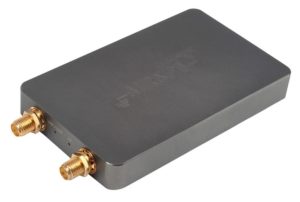In my recent post on the AirSpy HF+ vs Elad FDM-S2, I commented on medium wave reception only.
This past weekend I swapped out the Wellbrook ALA1530S+ for another Wellbrook loop, the ALA1530LN Pro. This LN Pro model is less likely to overload receivers at my suburban Tacoma, WA location. Both AirSpy and Elad radios performed admirably with the LN Pro and it was nearly impossible to find any reception differences on medium wave.
Before the antenna swap though I experimented with inline attenuation modules (“bullets”), typically used in cable TV installations. I used the same sample rates on the SDRs as described in the previous article. After some tests with different attenuation levels, I came to the following conclusions during daytime comparisons:
FDM-S2 with ALA1530S+ loop, medium wave: needs a minimum of 6 dB attenuation to avoid overloading. Anything less causes saturation of the spectrum & waterfall, “crunching” overload noises, and minimal or no received signal.
HF+ with ALA1530S+ loop, medium wave: I had to search diligently to find any signs of false signals or overloading, but finally noticed a weak image or spur of a S-9+60 dB (-13.5 dBm) local station on 1560 that was appearing very weakly on 1270 kHz, mixing with the station on that frequency. Sometimes it was there, other times the spur or image would drop down and disappear, leaving the 1270 signal alone. If I added just 3 dB of attenuation in the antenna’s feed line, the interference from the 1560 station was gone for good. The S-9+60 dB station is a very strong signal; it’s impressive that the AirSpy HF+ deals with this and similar powerhouse signals so well.
Long wave: Below are two screen captures from my local long wave reception in the evening, made moments apart with each receiver.
FDM-S2
As you can tell, there are a half dozen or so additional signals seen on the HF+ below 200 kHz that do not appear on the FDM-S2. These extra spikes are images or spurs from medium wave signals that were missing from the FDM-S2’s reception–bravo Elad! However, the remaining spikes on both radios below 200 kHz seemed to be noise or interference.
Each receiver had roughly equal performance in the bulk of the long wave spectrum, when I did A-B comparisons on the same beacon signals. I’m not a LW or NDB DXer however, so I can’t claim any expertise on these frequencies. In short, though, both radios seem neck-and-neck from about 200 to 500 kHz.
The DXer of LW frequencies may want to look elsewhere for a better performing radio than either the FDM-S2 or HF+. SWLing Post reader Tudor Vedeanu has commented that the SDRPlay RSP1A and the Eton E1 work very well at long wave.
Guy Atkins is a Sr. Graphic Designer for T-Mobile and lives near Seattle, Washington. He’s a regular contributor to the SWLing Post.




Thanks for the update, Guy. Please note that there were many updates in libairspyhf that are not included in the ExtIO yet. One of these updates improves the in-band image rejection, which might be related to the 1270 kHz spike. Andrea, the author of the ExtIO is working on an update. SDR# already includes the changes.
That’s great news, prog! Thanks for letting us know about these improvements.
My good DXing friend and HF+ owner Bill Whitacre is really warming up to SDR#. I will be giving it a try myself as I value his opinion. If he and I can get a recording scheduler plug-in working for medium wave use, SDR# will definitely be on my shortlist for consideration.
I also want to try out the improved NR algorithm in the latest SDR#; I was impressed with the recent audio comparisons that were posted.
Thank you Guy. In addition to these host software improvements, I had a discussion with STM about other firmware improvements based on performance reports in real world use cases, like yours. I have no ETA yet, but things look very promising.
Excellent update, Guy. No doubt, the HF+ is proving to be a fantastic value in the realm of mediumwave and shortwave. I’m impressed that it needs so little attenuation with the Wellbrook.
Likely because I don’t have a powerhouse AM station nearby, all of the longwave images I’ve discovered on the HF+ originate from powerhouse HF broadcasters (RHC, CRI, etc).
Thanks again for sharing your update, Guy!